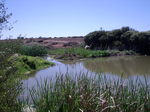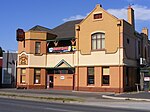Dry Creek explosives depot
2 ft 6 in gauge railways in AustraliaBuildings and structures in AdelaideExplosivesMagazines (artillery)Ports and harbours of South Australia ... and 3 more
Railway lines in South AustraliaSouth Australian Heritage RegisterUse Australian English from March 2015

The Dry Creek explosives depot was a secure storage facility near Port Adelaide from 1906 to 1995, serving the construction, mining and quarrying industries of South Australia, as well as the mines of Broken Hill in New South Wales.
Excerpt from the Wikipedia article Dry Creek explosives depot (License: CC BY-SA 3.0, Authors, Images).Dry Creek explosives depot
Cavan Road, Adelaide Dry Creek
Geographical coordinates (GPS) Address Website Nearby Places Show on map
Geographical coordinates (GPS)
| Latitude | Longitude |
|---|---|
| N -34.828347 ° | E 138.57998 ° |
Address
Greenfields Wetlands
Cavan Road
5094 Adelaide, Dry Creek
South Australia, Australia
Open on Google Maps




